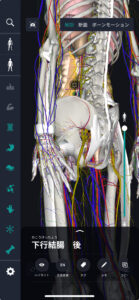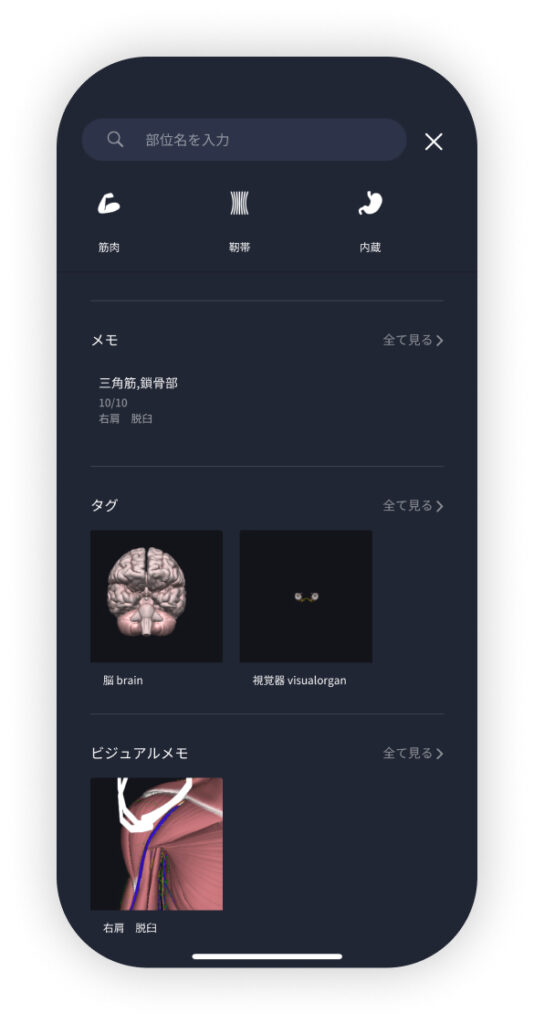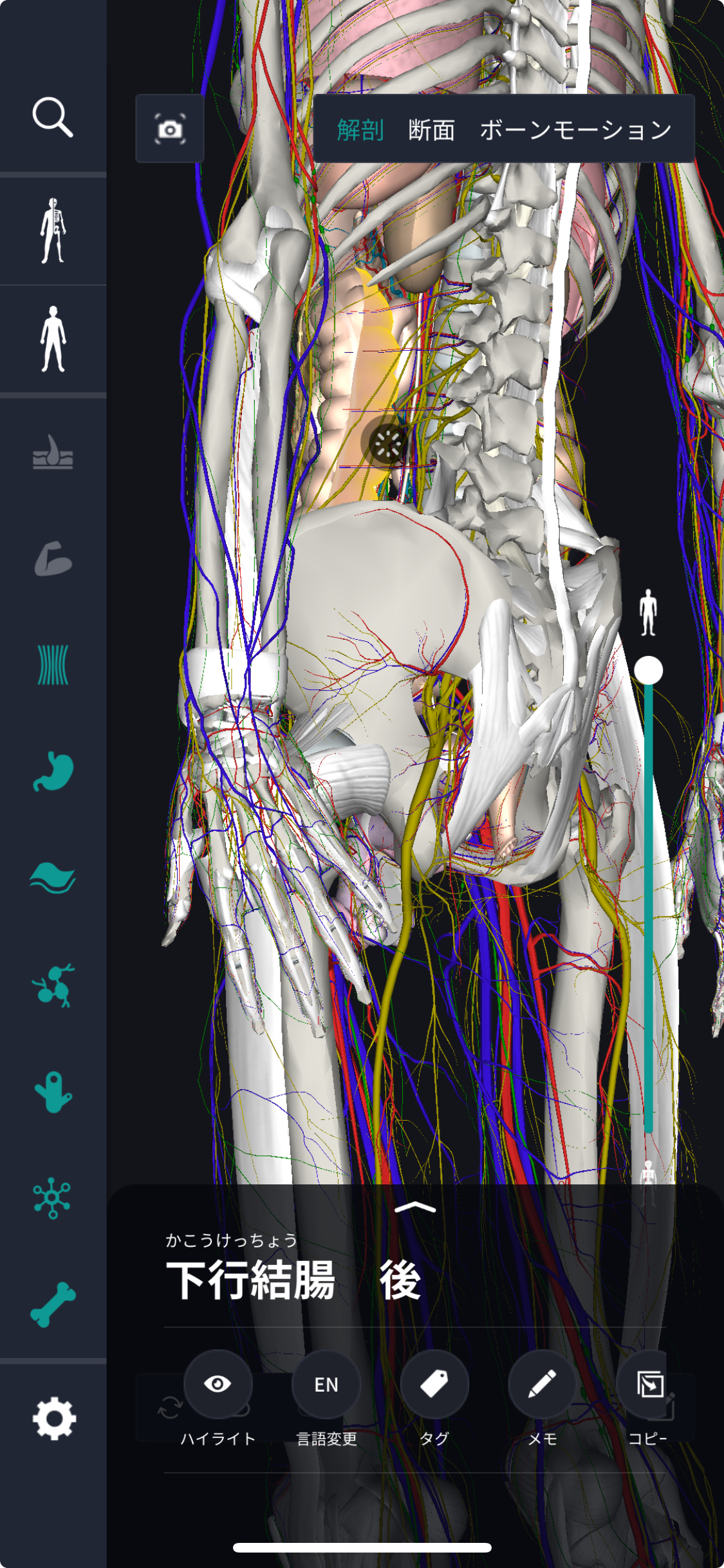beginning
In this article, I will explain effective study methods, starting with knowledge of specialized parts in human anatomy.
In human anatomy, it is necessary not only to memorize the names of various organs, muscles, and bones, but also to remember where they are located in the body. Therefore, it is necessary to learn as efficiently as possible.
I hope you can read this article and use the app to deepen your understanding even a little bit.
Now, I will explain the contents of the “descending colon” and how to study human anatomy.
teamLab Body Pro Free Download
A 3D anatomy app that shows all the structures of the human body
Download teamLab Body Pro here!

What is the descending colon?
In the anatomy application, you can view a selection of anatomy 3D models. In this model, there are various observation methods such as surfaces, cross-sections, and nervous systems. This time, I'll explain using an anatomy application.
About the descending colon

Study points
The location and structure of the descending colon
The descending colon is located on the left side of the body as part of the large intestine. The large intestine is the last part of the digestive tract, and the descending colon is the part that runs vertically near the lower back on the left side. The descending colon is next to the transverse colon, and functions as the part where the contents of the intestine change direction from horizontal to vertical. This part is approximately 25 to 30 cm long. The structure of the descending colon, like the rest of the large intestine, consists of layers such as the mucosal layer and intrinsic muscle layer surrounding the lumen. The mucous layer secretes mucus that lubricates the intestines and protects the lining of the intestinal tract. There is a muscle layer on the outside, which is responsible for moving contents through peristalsis. The descending colon, which starts just below the lower back and extends above the pelvis, plays an important role in defecation reflexes in response to internal intestinal pressure and stimulation. This process, which sends unnecessary residue to the rectum due to bowel movements, plays an important role in overall gastrointestinal regulation and overall health.
The role and function of the descending colon
The descending colon is responsible for some of the most important functions in the large intestine. Its main role is the absorption of water in the intestines and aid in the formation and movement of feces. After food has passed through the small intestine, most of its nutrients are already absorbed, and it is mainly water and undigested substances that reach the descending colon. The descending colon effectively absorbs the water left behind in it and solidifies the contents. This process allows the body to reuse water and maintain electrolyte balance. Also, the descending colon uses intestinal peristalsis to push solidified contents towards the rectum. This allows the body to efficiently excrete unnecessary substances and complete the digestive process. Furthermore, there are many gut bacteria in the descending colon, and they also contribute to the production of some vitamins and substances that aid digestion. Thus, the descending colon plays an important role in the final stage of digestion and plays a major role in maintaining daily health.
English notation for descending colon
The descending colon is expressed as “descending colon” in English. This expression clearly indicates its anatomical direction and location, and means that it is located downward within the digestive tract. When writing in English, it is generally written in lower case, except when used at the beginning of a sentence or in the title. In medical contexts and documents relating to anatomy, it is sometimes written in italics _ (italicized) _ when particular emphasis is desired. Also, in medical and anatomical documents, it is important to maintain consistency with other relevant parts of the intestine, such as the ascending colon (ascending colon), transverse colon (transverse colon), and sigmoid colon (sigmoid colon). This allows health care professionals to effectively communicate with each other about each part of the gut. When “descending colon” is used in sentences, it is usually used in the context of explaining its function and relationships with other digestive organs. For example, there are expressions such as “The Descending Colon Plays a Critical Role in Digested Water from Digested Material (the descending colon plays an important role in absorbing water from digested matter),” which helps readers understand its function and importance.
How to study human anatomy
I will explain specific study methods using human anatomy applications.
Check your past learning history and practice repeatedly
Here are the steps to check your anatomy learning history and practice iteratively effectively.
1. Check your learning history in the app
Reviewing your learning history with the application is an important step in effectively advancing anatomy learning. First, launch the app and go to the learning history section from the main menu. Many anatomy apps are designed to show your progress in the form of graphs and lists, so you can visually check which parts you've learned about and how much time you've spent.
By using this data, you can understand which areas you have strengths in and where you need to spend more time and effort. We also recommend using a dedicated tag or notebook function to mark areas you are particularly weak at or where you need to relearn. Regularly checking your learning history and looking back on past learning content will lead to efficient review and deepening understanding.
2.Make a plan for iterative learning
Making an efficient repetitive learning plan based on learning history is extremely effective in promoting knowledge retention. First, identify weak points and areas where you need to relearn. Next, arrange these study items into a weekly or monthly calendar and create a specific study schedule. By proceeding in a planned manner, you can learn each part evenly and avoid packing in a large amount of information at once.
Using a task management app or digital calendar to set study reminders is effective. Also, it's important to have the flexibility to regularly review progress and revise plans as needed. By proceeding with your studies in a planned manner with goals, you can efficiently acquire anatomical knowledge.
3.Use 3D features to learn visually
By utilizing the 3D function, learning anatomy is easier to understand visually. The 3D model shows the structure of the human body three-dimensionally, and each part can be observed in detail. This makes it possible to intuitively grasp positional relationships between deep muscles and organs that are difficult to capture in a planar view. For example, you can learn even the smallest details by rotating specific muscles and bones and zooming in and out.
Also, there are many apps that have the function of displaying cross-sectional views of each part using a 3D model, which is useful for deepening understanding of internal structures. This diversity of visual information helps with memory retention and improves immediate responsiveness in tests and practice situations. By utilizing the 3D function and learning visually, you can learn anatomy knowledge more deeply and efficiently.
Use the memo function concretely

Test your learning regularly in the form of quizzes
Regularly testing what you've learned in a quiz format is a very effective way to anchor your anatomy knowledge. Quiz-style tests help you objectively grasp your level of understanding and areas you lack while repeating knowledge.
For example, by using a learning app to conduct quizzes every specific period, you can reconfirm what you've learned and strengthen your memory. There are a wide range of quiz formats, such as multiple choice questions, fill-in-the-blank questions, and short answer questions, and each helps understanding from a different angle and develops the ability to utilize various types of knowledge.
Get feedback
If possible, get feedback from other learners and experts. It helps you find your own gaps in understanding and areas for improvement. You can also keep yourself motivated to learn by regularly testing yourself. Feeling a sense of accomplishment and progress increases motivation for continuous learning.
summary
This time, I explained how to study about the “descending colon” using an application!
Thank you for reading this far.
I would be happy if reading this article helped you learn about anatomy.
Learning is a long, never-ending journey, but I sincerely wish you all the best. Let's continue to study together and work hard for the national exam!
Please look forward to the next blog.



